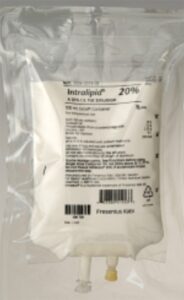-
Adopt
-
Veterinary Care
Services
Client Information
- What to Expect – Angell Boston
- Client Rights and Responsibilities
- Payments / Financial Assistance
- Pharmacy
- Client Policies
- Our Doctors
- Grief Support / Counseling
- Directions and Parking
- Helpful “How-to” Pet Care
Online Payments
Referrals
- Referral Forms/Contact
- Direct Connect
- Referring Veterinarian Portal
- Clinical Articles
- Partners in Care Newsletter
CE, Internships & Alumni Info
CE Seminar Schedule
Emergency: Boston
Emergency: Waltham
Poison Control Hotline
-
Programs & Resources
- Careers
-
Donate Now
 By Megan Whelan, DVM, DACVECC, CVA
By Megan Whelan, DVM, DACVECC, CVA
www.angell.org/emergency
emergency@angell.org
617-522-7282
Intravenous Lipids, also referred to as intravenous fat emulsion (IFE) or intravenous lipid emulsion (ILE) have been routinely used in parenteral nutrition for veterinary patients, either alone or as a component of total parenteral nutrition. In addition, lipid emulsions have served as a delivery vehicle for hydrophobic drugs like propofol.1 ILE is made of neutral, medium to long-chain triglycerides derived from plant oils (soybean, safflower), egg phosphatides and glycerin.2 Specific brands include Intralipids, Liposyn, and Medialipid. At Angell Animal Medical Center we use Intralipid 20%, made by Baxter and packaged in 500 ml bags. It has a maximum shelf life of 18 months, and has no specific storage requirements. Once spiked, the bag is good for 24 hours, and the cost per bag to the client is $44.49.
There are no reported definitive uses of ILE in the human or veterinary literature. However, its use has been reported in humans as adjunct treatment for local anesthetic systemic toxicosis (LAST). In animals, there are many case reports of its use in dogs 3,4,5 and cats1,6,7 with various toxicities—specifically with lipophilic compounds. Lipophilic compounds are those that combine with or dissolve with lipids. Reports of ILE use in veterinary medicine include use with overdoses of macrocyclic lactones, local anethestics, permethrin, baclofen, and some calcium channel blockers. A recent article details the use of ILE in the treatment of severe diitiazem toxicosis in a dog along with high-dose insulin therapy.4 Additionally, there have been multiple review articles regarding lipid use in small animal poisoning. 2,8,9
The exact mechanism of action of ILE is not known but there are two main theories: the metabolic theory and the “lipid sink” effect. The latter is most favored and supposes that ILE acts as a discrete department in the plasma which prevents the lipophilic compound from reaching its site of action.2 Regardless of its exact mechanism of action, physicians and veterinarians can document their experiences with ILE on the “Lipid Rescue” website (http://www.lipidrescue.org).2
Lipids are usually given IV in a peripheral catheter, but can be given in a central catheter as well to avoid potential phlebitis. Aseptic technique should be used when administering ILE to prevent bacterial contamination and secondary sepsis in patients. Reported dose ranges in the literature include boluses of 1.5 ml/kg-2.0 ml/kg over 2-15 minutes, then as a CRI 0.06 ml/kg/min to 0.5 ml/kg/min for multiple hours.2 Despite the large dosing range ,0.25 ml/kg/min for 30-60 minutes is commonly used. No maximum daily dose has been determined in veterinary patients.6 Regardless of the starting or final dose amount, the neurological or clinical response should guide your therapy. One case report describes resolution of blindness in a dog that was exposed to an ivermectin horse dewormerand treated with ILE.3
Lipids are relatively cheap, and easy to administer if you have them on site or can obtain them same day from a local hospital. They appear to be relatively safe, and the serum should be monitored about every 2 hours for evidence of lipemia. If lipemia is seen, no further administration of ILE should occur. Potential adverse effects mentioned include lipemia which can cause interference with lab tests, lipid emboli in neonates, and secondary pancreatitis. In addition, hypersensitivity reactions and possible interference with other drugs can be seen.2 One study did show that short-term administration of soybean oil-based ILE can decrease neutrophil function in dogs.3 In another case series, one dog did have swelling and pain from extravasation of the ILE.5 Since there are no current studies evaluating the safety of ILE use in acute toxicities6, owners should be informed of its off-label use.7
Lipids offer an easy potential antidote and can help to accelerate the recovery of the patient. However, it may not always be effective and should be used as an adjunct treatment. Further research needs to be conducted in a standardized manner in order to determine specifics forILE dosing, most effective time period for administration, length of administration, and which patients are most likely to respond.
For more information about Angell’s Emergency/Critical Care service, please visit www.angell.org/emergency. Dr. Whelan can be reached at 617-522-7282, or by e-mailing emergency@angell.org.
References
- O’Brien, T.Q. et al. (2010) Infusion of a lipid emulsion to treat lidocaine intoxication in a cat. Journal of American Veterinary Medical Association 237, 1455-1458.
- Gwaltney-Brant, S. and Meadows, I. (2012) Use of Intravenous lipid emulsions for treating certain poisoning cases in small animals. Veterinary Clinics of North America: Small Animal Practice 42, 251-262.
- Epstein, S.E. and Hollingsworth, S.R. (2013) Ivermectin-induced blindness treated with intravenous lipid therapy in a dog. Journal of Veterinary and Emergency Critical Care 23, 58-62.
- Maton, B.L. et al. (2013) The use of high-dose insulin therapy and intravenous lipid emulsion to treat severe, refractory diltiazem toxicosis in a dog. Journal of Veterinary Emergency Critical Care 23, 321-327.
- Bates N. et al. (2013) Lipid infusion in the management of poisoning: a report of 6 canine cases. Veterinary Record 172, 339.
- Kuo, K. and Odunayo, A. (2013) Adjunctive therapy with intravenous lipid emulsion and methocarbamol for permethrin toxicity in cats. Journal of Veterinary Emergency Critical Care 23, 436-441.
- Haworth, M.D. and Smart, L. (2012) Use of intravenous lipid therapy in three cases of feline permethrin toxicosis. Journal of Veterinary Emergency Critical Care 22, 697-702.
- Fernandez, A.L. et al. (2011) The use of intravenous lipid emulsion as an antidote in veterinary toxicology. Journal of Veterinary Emergency Critical Care 21, 309-320.
- Kaplan A. and Whelan, M. (2012) The use of IV lipid emulsion for lipophilic drug toxicities. Journal of American Animal Hospital Association 48, 221-227.
